U.S. Customs and Border Protection has issued its latest ruling on the Jones Act’s role in the development of offshore wind projects off the nation’s coasts. The latest ruling now builds on earlier rulings that are now stacking up to have big implications for American mariners and ships.
The Jones Act requires that goods shipped between U.S. ports are transported on ships that are built, owned, and operated by United States citizens or permanent residents.
As we have been following, CBP on January 27, 2021 for first time issued a ruling that expressly found that the Jones Act applies to the transportation of merchandise from a U.S. port to a location on the U.S. outer continental shelf for the purpose of the development and production of wind energy.
The ruling was the first following an amendment to the previously passed National Defense Authorization Act for 2021, which included a key provision affirming that the Outer Continental Shelf Lands Act (OCSLA), and its application of the Jones Act in offshore energy activities, applies to offshore wind and other renewable energy in addition to oil and gas.
A second ruling just a few days later again addressed the issue, providing significant guidance on the use of foreign-flag vessels in connection with offshore wind activities, including important guidance on what is treated as “vessel equipment”.
Now, in third ruling on March 25, 2021, CBP actually significantly modified its first ruling, particularly as it relates to the use U.S. coastwise qualified and non-U.S. coastwise qualified vessels (i.e. American or foreign ships and crews) for purposes of “scour protection”, which involves transporting and depositing materials on the seabed in order to protect turbine foundations.
The rulings essentially provide clarity and guidance on specific issues. Law firm Holland & Knight discusses the implications of the latest ruling in an emailed alert.
“First, the three rulings taken together indicate CBP’s willingness to reach back to a substantial body of prior interpretative principles largely developed in connection with oil and gas activities,” the the Holland & Knight article said. “It has been unclear how CBP would apply some of those principles moving forward and these rulings provide some guidance in that regard.
“Second, CBP’s Jan. 27 and March 25 rulings indicate that despite looking to existing analogous principles, CBP is willing to set new precedent for offshore wind activities.”
For example, although the CBP’s more recent ruling revoked part of its initial January 27 ruling, in doing so it offered a new and rather broad interpretation of what will now constitute a “coastwise point,” according to Holland & Knight.
“Finally, the fact that CBP is actively issuing rulings in the space is in and of itself an important, if not critical, trend,” the article said.
This is all extremely significant considering the Biden Administration has just revealed a plan to expand the nation’s offshore wind capacity to 30 gigawatts by 2030, marking a major expansion from the nation’s current capacity.
“Anything close to the level of activity needed to achieve such goals will require virtually every permutation of available U.S. coastwise qualified vessels and permissible foreign-flag vessels,” according to Holland and Knight. “CBP’s active participation in the industry is a necessary and welcome trend.”
We reached out to Holland & Knight for some clarity on the foreign-flag vessel part:
“The Jones Act of course does not prohibit all vessel related activities on the OCS, as the rulings also reflect,” explained Gerald Morrissey, lead author of the article. “The point was… there are permissible activities that non-Jones Act vessels can undertake on the OCS, and given the tremendous scope of the anticipated offshore wind industry and ambitious timeframes on top of that, it is highly likely that the projects will need vessels from all permissible sources.”
In an interview on Wednesday, a senior official within the Biden Administration said the administration is aiming to transform the United States into the world’s leading offshore wind energy producer, an area that it has lagged for years.
“The distinction now is that we have a president and an administration that is really harnessing this opportunity to fight climate change and to create good paying union jobs,” said Amanda Lefton, director of the U.S. Bureau of Ocean Energy Management. “We will soon be leading in this industry.”
“We have an industry in the United States that knows how to do energy development in the Outer Continental Shelf,” she added.
Unlock Exclusive Insights Today!
Join the gCaptain Club for curated content, insider opinions, and vibrant community discussions.

 Join The Club
Join The Club













